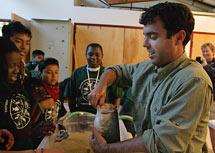
Handy Links
SLAC News Center
SLAC Today
- Subscribe
- Archives: Feb 2006-May 20, 2011
- Archives: May 23, 2011 and later
- Submit Feedback or Story Ideas
- About SLAC Today
SLAC News
Lab News
- Interactions
- Lightsources.org
- ILC NewsLine
- Int'l Science Grid This Week
- Fermilab Today
- Berkeley Lab News
- @brookhaven TODAY
- DOE Pulse
- CERN Courier
- DESY inForm
- US / LHC
SLAC Links
- Emergency
- Safety
- Policy Repository
- Site Entry Form

- Site Maps
- M & O Review
- Computing Status & Calendar
- SLAC Colloquium
- SLACspeak
- SLACspace
- SLAC Logo
- Café Menu
- Flea Market
- Web E-mail
- Marguerite Shuttle
- Discount Commuter Passes
-
Award Reporting Form
- SPIRES
- SciDoc
- Activity Groups
- Library
Stanford
Around the Bay
People: David Bernstein at Jasper Ridge
At a time of day when most graduate students are rolling over for another three hours of sleep, David Bernstein, a graduate student at the Stanford Synchrotron Radiation Lightsource, is standing thigh-deep in chilly water with a fishing rod. The newly-risen sun is gilding the grassy hills of Jasper Ridge Biological Preserve, just a few miles west of SLAC. Scrub oaks cast long shadows over Searsville Lake, where Bernstein is hoping to catch a largemouth bass—an invasive species of fish, and the perfect lesson for the East Palo Alto sixth graders who will arrive in a few hours.
Bernstein has always loved the outdoors. He credits this to his mother, whose idea of vacation differed considerably from that of their Philadelphia neighbors. "People went to the Jersey Shore, but we always rented these super quiet houses in Cape Cod, where there's nothing to do at all," he says, recalling summers spent chasing frogs through reeds and trying to catch fish. "I never really grew out of the 'I want to chase a snake and catch it' phase."
But exploring nature was just a hobby until Bernstein took Jasper Ridge's docent training class last year. Lasting for two quarters, the class covers "everything ecological," says Bernstein, including geology, hydrology, soil science, herpetology and local flora and fauna. "I can't rattle off the Latin names of every species I see, but I'm always biting off pieces," he says.
Bernstein now regularly leads tours of Jasper Ridge, sharing his knowledge with visitors. He's also one of the volunteers who teach a weekly ecology class to sixth-graders from Eastside College Preparatory School. Among other things, he's shown the students how to identify local endangered and invasive species, track mammals and measure the pH of water samples.
"It's amazing the level of the concepts they can grasp," he says.
Eastside is a combined middle school and high school for gifted children from local low-income neighborhoods. All of its graduates to date have enrolled in four-year universities, and about 98 percent of those are the first in their families to attend college. During a typical ecology class, a dozen hands will shoot skyward for every question Bernstein poses. But he says it's the field studies aspect—documenting the growth of a plant, or peering at soil under a microscope—that's crucial to teaching these precocious sixth graders to be good scientists.
"I like that it's an opportunity to make scientific observations, the same kind we would make [at SLAC] or any other lab," he says. "If you can get that sense of data and observations into their head at an early age, that makes a difference."
The experience has made a difference in Bernstein's life as well. An avid hiker, backpacker and fisherman, he says his newfound knowledge has opened up a whole new level in his enjoyment of the outdoors.
"I actually had no idea how much of an impact it would have on my life," Bernstein says. When he describes the breeding habits of local salamander or how glaciers carve out lakes, his eyes light up with the same passion he feels for his physics research.
"Whether you're scraping the ground for a tiny little flower or spending hours at a synchrotron, you're looking for things that are hard to notice," he explains. "When you uncover the details they can be kind of beautiful in their own right."
—Lauren Shenkman
SLAC Today, May 27, 2009
